Ease your hip pain with these 9 top hip bursitis exercises. Find out the safest moves for hip bursitis pain, and which ones to skip for effective relief.
If you’re experiencing pain and discomfort in your hips, you may be suffering from hip bursitis. Hip bursitis is an irritating condition that can range from slightly bothersome to very painful.
Feeling hip pain when you are lying in bed at night, or immediately when you stand up after sitting for a while are both signs of hip bursitis.
This condition is caused by inflammation in the hip joint’s bursa sacs, which are small, fluid-filled sacs that cushion the bones, tendons, and muscles near the joint.
While hip bursitis can be a frustrating condition to manage, exercising can provide significant lower body relief. In this article, we will explore the best hip bursitis exercises to help fortify muscles surrounding the waist and pelvis, alleviate your pain, and improve your quality of life.
Here are nine exercises you can do at home to treat your bursitis and work your whole body:
Workout Instructions:
- Follow the instructions on each exercise, focusing on your form and proper technique to avoid additional strain
- As you build strength, you can gradually increase the intensity and repetitions
- Many of these exercises require not equipment at all (a few require a resistance band, which you can find in my home gym equipment guide).
Glute Bridge
The glute bridge exercise engages your glutes, hamstrings, quads, and pelvis. In addition, you’ll feel a stretch and open the hips flexors and front of the body overall.
How to Perform a Glute Bridge:
- Lie on your back with knees bent and feet flat on the floor close to your glutes. Your knees should be in line with your hip bones.
- Place your arms flat on the floor at your sides and tuck your shoulders under your back.
- Press your palms into the ground as you raise your hips, squeezing your glutes and abdominals. Keep your neck relaxed on the mat.
Recommended Reps: 10-12. Hold for 3 seconds at the top, lower slowly to flat on the floor.
Equipment: None
The glute bridge is also a great option for seniors because it’s gentle, but powerful. I put together a handy guide to hip strengthening exercises for seniors that take age and ability into special consideration.
It’s never too late to start!
Fire Hydrant
The fire hydrant exercise is important for tackling the piriformis muscle and strengthening the pelvic joint as a whole. Unweighted, this exercise can be done by anyone and is great for increasing your range of motion.

How to Perform the Fire Hydrant Exercise:
- Begin on your hands and knees with hands directly under shoulders and knees directly under hips.
- Use the outer-thigh muscles and glutes to lift one knee out and up, keeping your knee bent at a 90-degree angle.
- Lower your leg and repeat on the other side.
Recommended Reps: 10-12 per side.
Equipment: None
Resistance Band Butt Blaster
The resistance band butt blaster exercises tackles your glutes without putting excessing stress on your hips.
How to Perform a Resistance Band Butt Blaster:
- Kneel on floor and wrap band under right foot, and place hands down under shoulders holding handles against the floor.
- Lift right knee off the floor slightly and push right foot back to extend leg straight against the band, squeezing your glute.
- Release slowly bringing knee back in to a bent position. Continue for desired reps and switch feet.
(Be sure you don’t pull the knee is too far after pressing back; the knee under the hips is the start and end position.)
Recommended Reps: 10-12 per leg.
Resistance Band Outer Thigh Press
The resistance band outer thigh press exercise works your abductors (outer thighs) to help balance strength across the entire pelvic area. It also builds strength in your leg and core muscles.
How to Perform a Resistance Band Outer Thigh Press:
- Lay on your back with legs straight in the air above hips.
- Place the center of the band around the bottom of your feet and hold handles together at your chest.
- Press the feet wide open until legs are in a straddle position and band is tight. Release slowly.
Recommended Reps: 16-20 total: 8-10 per side, alternating.
Equipment: Resistance Band
Forearm Side Plank
Isometric strength moves, like the forearm side plank, are extremely important for building strength and stability. This plank exercise strengthens the outer side of your obliques.
How to Perform a Forearm Side Plank:
- Being lying on the floor with your forearm on the mat with shoulder stacked over the elbow. Legs are long with feet stacked on top on each other.
- Lift your body into a side plank position, keeping your lower knee on the floor and your abdominals engaged. Try to to let your hips rise or drop.
Recommended Reps: Hold for 30 seconds on each side
Equipment: None
Sleeping Pigeon Pose
This sleeping pigeon stretch opens up the piriformis and is also a great iliotibial band stretch and activation for each side.
How to Perform Sleeping Pigeon Pose:
- Begin in a plank position. Tighten your abdominals and pull your right knee toward your right hand placing your right foot as close to your left hand as you can.
- Keep your back leg long and keep your hips even as you relax your weight through the middle of your hips.
- Slowly begin to lower your chest over your front shin relaxing forehead on the mat and arms stretched overhead.
- Breathe and hold for 30 seconds. Slowly lift chest up, step back into plank and switch sides.
Recommended Reps: Hold for 30 seconds on each side.
Equipment: None
Seated Straddle Splits
The seated straddle splits will open up your inner thighs and activate your hip and leg muscles.
How to Perform the Seated Straddle Splits:
- Begin in a seated position with legs stretched out open to the sides as far as you can and toes pointed up.
- Place hand on the floor in front of you and slowly walk your hands forward until forearms are resting on the floor.
- Keep chest lifted and spine long as you breathe and hold for desired length.
Recommended Reps: Hold for 30 seconds to 60 seconds.
Equipment: None
Yogi Squat Pose
The yogi squat pose is another IT band stretch and hip activating movement. It’s a great move to add at the end of any workout!
How to Perform the Yogi Squat Pose:
- Begin on feet, crouched down with tailbone between ankles and hands in prayer at chest.
- Continue to press hands firmly together while at the same time pressing elbows against inner thighs.
- Hold and breathe for desired length.
Recommended Reps: Hold 30-60 seconds.
Equipment: None
Inner Thigh Squeeze
The inner thigh squeeze move strengthens the adductors (inner thighs) which are typically weak and add to dysfunctional pelvic movement.
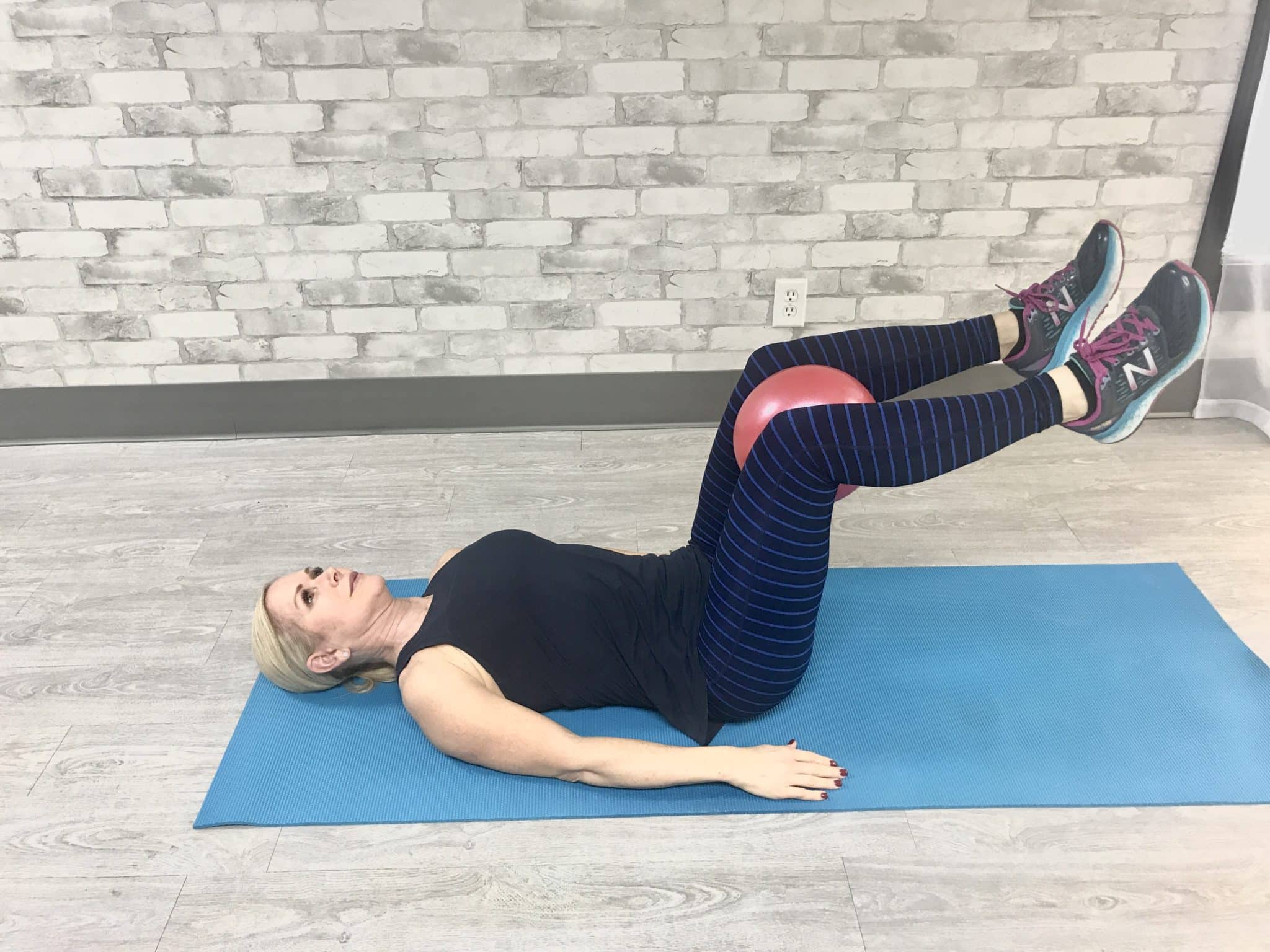
How to Perform a Inner Thigh Squeeze:
- Lie on your back with your feet in the air and knees bent, pull your low abs in so your lower back is gently pressing into the floor.
- Squeeze the pilates ball or towel tightly between your knees as you pull your belly in at the same time.
Note: If this bothers your flexors, it can be done with feet flat on the floor and knees bent.
Recommended Reps: 20 repetitions.
Equipment: small pilates ball, volleyball, or rolled-up towel
[adthrive-in-post-video-player video-id=”BSgpR9w8″ upload-date=”2020-02-26T20:02:09.000Z” name=”9 Best Exercises for Hip Bursitis” description=”Hip bursitis is an irritating condition that can range from slightly bothersome to very painful. Specific hip exercises can help strengthen the muscles surrounding the hip, and stretches can open up tight and painful areas of the hip. Many of these moves require no equipment, while a few of them require a resistance band to do the trick. Here are nine exercises you can do at home to help treat your hip bursitis. ” player-type=”default” override-embed=”default”]
Other Beneficial Exercise for Hip Bursitis
If you suffer from hip bursitis, finding the right cardio exercise can be challenging. High-impact activities like running and jumping can cause additional pain, making it difficult to stick to a regular workout routine.
However, low-impact cardio exercises can provide a great alternative, offering numerous health benefits without putting excessive strain on the hip joint.
Here are some of the best low-impact cardio exercises for hip bursitis relief:
| Yoga | These yoga poses to relieve tight hips. Add them to your daily routine! |
| Walking | This is a personal favorite! Walking is a great low-impact cardio exercise that is gentle on the joints and helps improve balance and coordination. You can even add a walking pad into your weekday routine to walk while you work. (I walk at 1 mph while I work on my computer.) |
| Swimming | While it’s not always easy to get to a pool, swimming is a fantastic form of low-impact aerobic exercise that provides whole-body workout, strengthens muscles and joints, and enhances cardiovascular fitness. Follow this beginner’s guide to swimming to get started. |
| Cycling | Gaining in popularity, cycling on a stationary bike or outdoors on level terrain (low resistance) provides a low-impact workout that improves cardiovascular endurance and strengthens the leg muscles. |
| Elliptical Training | A workout classic. Elliptical machines simulate walking or running without the impact on the joints, and this exercise helps to build cardiorespiratory fitness and burn calories. Here are three elliptical workouts to get you started! |
| Water Exercise | In addition to swimming laps, other water exercises can be a great way to help relieve hip bursitis symptoms. The buoyancy of the water can help reduce joint stress and impact, creating a low-impact environment for exercise. Try my 30 minute pool workout for seniors. |
Low-impact cardio exercises are typically safe and joint-friendly, making them ideal for individuals with hip bursitis looking to stay active while minimizing pain and discomfort.
However, these movements are repetitive motions. I do recommend connecting with your healthcare professional or physical therapist to assess your situation and decide when beginning regular low impact exercise is recommended.
Hip Bursitis Exercises to Avoid
While exercise is essential for managing hip bursitis symptoms, it is equally important to avoid exercises that can aggravate the condition. High-impact exercises that put excessive stress on the hip joint should be avoided to prevent further injury and discomfort.
These are the most common exercises to avoid when suffering from chronic hip bursitis:
- Running. High-impact running exercise increases pressure on the hip joints.
- Plyometrics. Exercises that involve jumping put excessive pressure on the hip joints and aggravates inflammation.
- Lunges. Even though popular, lunges stress the hip joint and can be painful for those suffering from bursitis.
- Squats. Similar to lunges, deep squats put additional stress on the hips and can cause discomfort.
Avoiding these exercises will help prevent worsening of hip bursitis symptoms and promote healing.
Remember to consult your healthcare provider before starting any new exercise program.
What Is Hip Bursitis?
Hip bursitis is a common condition that results from inflammation of the bursa sacs in the hip joint. A bursa sac is a small, gel-like pillow that sits between your bones and their connective tissues, acting as a sort of shock absorber.
You have bursa sacs in your hips, shoulders, elbows, knees, and heels. However, the bursae can become inflamed and cause pain and discomfort.
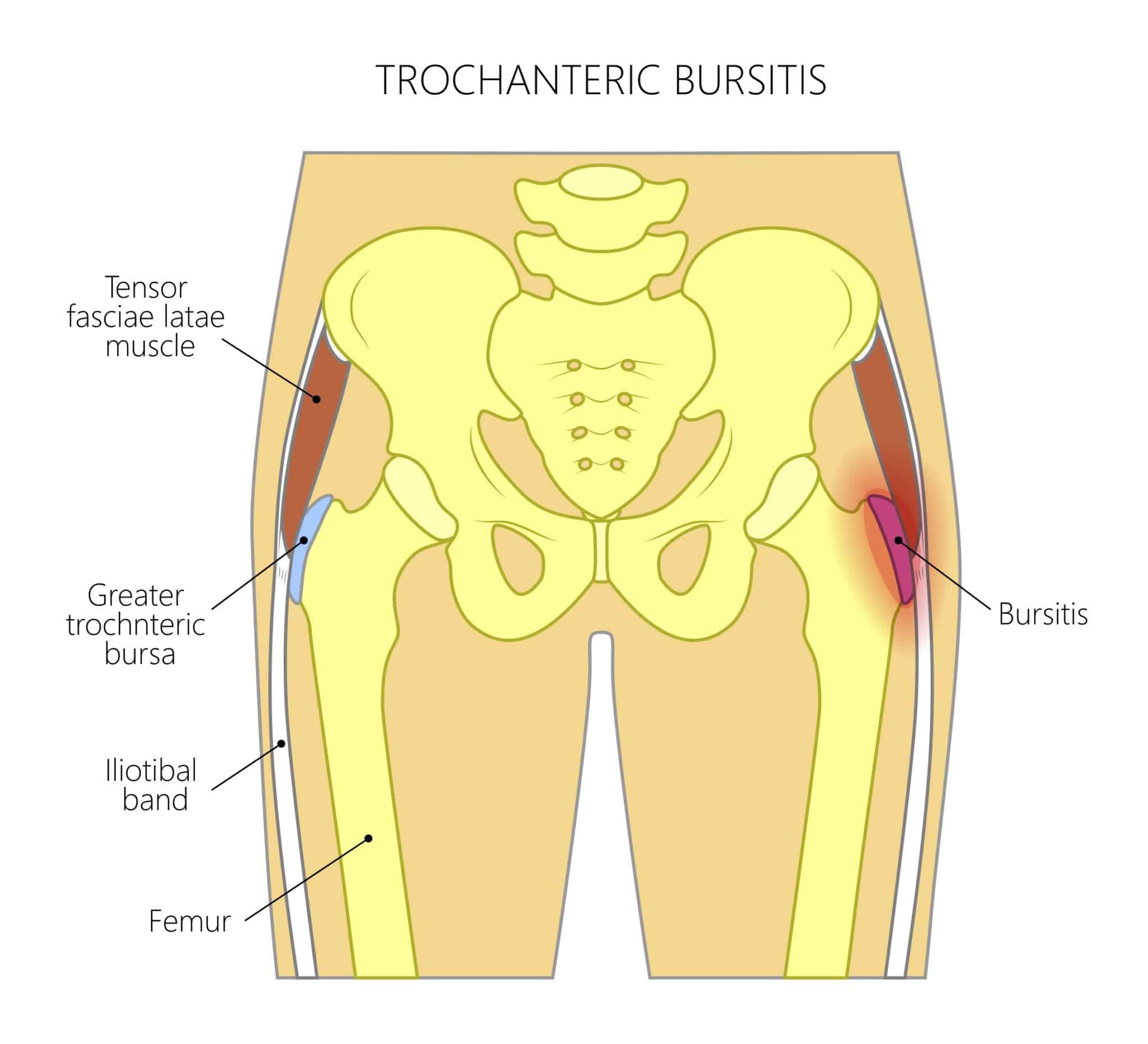
The most common causes of hip bursitis include repetitive motions, such as running or cycling, which can irritate the bursae and lead to inflammation.
According to the American Academy of Orthopaedic Surgeons, two major bursae in the hip can become injured or inflamed. The more common of the two, Trochanteric Bursitis, is inflammation to the bursa covering the greater trochanter, which sits at the bony point of the hip bone.
Trochanteric bursitis results in pain on the outer side of the hip which usually increases with prolonged walking or climbing stairs. The pain is felt more while getting up from a chair and in the night when lying on the affected side.
The other bursa located on the inside of the hip near the groin is called the iliopsoas bursa and is less common.
Both are treated in a similar way.
Common Symptoms of Hip Bursitis
Symptoms of hip bursitis may include pain, swelling, and stiffness in the hip, as well as difficulty walking or bending the affected joint.
The symptoms of hip bursitis vary from person to person, but the most common are:
- Hip pain that is sharp at first and then becomes aching over time
- Hip tenderness which seems more generalized in the entire hip area
- Pain that gets worse after prolonged or repetitive activity
- Leg pain that extends from the hip down the side or back of the leg
- Pain or discomfort when climbing stairs, running or cycling
Important note: if you have warmth and redness in the area along with fever or illness, you could have septic bursitis which comes from infection. Be sure to see your doctor!
What Causes Hip Bursitis?
There are a number of things that can cause bursitis of the hips, from a direct fall to running too many miles. Let’s take a look at some of those things that put you at risk.
Here are some of the most common causes of hip bursitis:
| Injury | A traumatic injury or fall can cause hip bursitis. |
| Repetitive Motion | Common repetitive motions like cycling, running, climbing or lots of squats, could cause hip bursitis to flare up. Be very cautious when doing any activity that causes increased load on your joints and is high in repetition. |
| Leg-Length Inequality | Believe it or not, a surprising number of people have one leg that is slightly shorter than another (1.5 cm or more). This can affect your gait, causing issues similar to the repetitive use problem resulting in bursitis. |
| Arthritis | Bursitis can come from arthritis. The same inflammation that comes with arthritis can extend into the bursa. |
| Spine Diseases | Conditions like scoliosis can cause problems with the movement pattern of your hips and play a role in bursitis. |
| Prior Surgery | Like spine diseases, prior surgeries such as implants or hip replacements can throw off your gait and movement patterns, creating inflammation. |
The Importance of Exercise for Hip Bursitis
Regular exercise can provide multiple benefits to those suffering from hip bursitis. One of the most significant advantages is relief from pain and stiffness.
Hip bursitis often resolves with targeted exercises and rest from aggravating activities. Exercises for hip bursitis will include movements that strengthen the hip and improve mobility of the joint.
I always say “motion is lotion.”
When you move, synovial fluid helps to cushion and lubricate the joint. (Synovial fluid is a thick liquid located between the joints).
When performed correctly, exercises for hip bursitis can also lead to improved posture and a reduction in the incidence of further injury or strain. Additionally, physical activity stimulates blood flow, which can promote healing and reduce inflammation.
It is essential to note that exercise should be performed with caution to prevent further damage to the affected area. Always consult a healthcare professional before starting a new exercise routine, especially if experiencing chronic pain.
Care And Treatment: Rest, Ice, Compress, and Elevate (RICE)
It is very important to rest the injured area until you don’t have pain.
In other words, if running too many miles is the cause of your issue, continuing to run daily miles will only aggravate your muscles. A healthcare provider can suggest treatments based on the pain severity and the cause.
However, in most cases the RICE method will work: rest, ice, compress, elevate, and repeat.
According to the Cleveland Clinic, how to treat hip pain at home with the RICE method:
| Rest | Stop the physical activity that caused the pain to avoid making the injury worse. |
| Ice | Apply an ice pack or cold compress for 10 to 15 minutes every hour for the first day after your injury. After one day, you can apply ice every three to four hours. Don’t apply ice directly to your skin (wrap the ice pack in a towel or washcloth). |
| Compression | Compression helps reduce blood flow to your injured hip and reduces swelling. Apply a compression bandage or wrap around your hip. You can also wear compression shorts or pants to help keep pressure on your hip. |
| Elevation | If possible, lift your hips and lower body above the level of your heart. Support your leg with pillows, blankets or cushions. |
You can also take anti-inflammatories like ibuprofen or naproxen if needed and directed by your doctor.
Precautions and Modifications for Hip Bursitis Exercises
When performing hip bursitis exercises, it’s essential to take proper precautions to avoid further injury and ensure safe and effective workouts.
Here are some exercise modifications and safety tips to consider:
Start Slow
If you’re new to exercise or haven’t worked out in a while, start slow and gradually increase the intensity and duration of your workouts. This approach will help you avoid overexertion and reduce the risk of injury.
Avoid High-Impact Exercises
High-impact exercises like running, jumping, and plyometrics can aggravate hip bursitis symptoms and cause further inflammation. Instead, opt for low-impact exercises like swimming, cycling, and walking to reduce joint stress.
Listen to Your Body
Pay attention to your body’s signals and adjust your workout intensity accordingly. If you experience pain or discomfort during an exercise, stop immediately and rest.
Resume the exercise only if the pain subsides.
Use Proper Form
Using proper form is crucial while performing hip bursitis exercises. Incorrect form can put additional strain on the hip joint and cause further injury.
Ensure that you maintain proper posture, engage the correct muscles, and take slow, controlled movements while performing each exercise.
Avoid Overstretching
While stretching is essential for relieving tension and increasing flexibility, overstretching can cause muscle strain and aggravate hip bursitis.
These are my favorite hip opening stretches to relieve your hips. I recommend avoiding deep, intense stretches and opt for gentle, controlled movements.
With these precautions and modifications, you can perform hip bursitis exercises safely and effectively.
Additional Treatments for Hip Bursitis
In addition to exercise, there are other treatments that can help manage hip bursitis.
Physical Therapy
Physical therapy is an effective way to regain hip mobility and strength, and reduce pain and inflammation. Your physical therapist may recommend even more specific exercises, stretches, and manual therapy techniques tailored to your condition.
Pain Management
Pain management techniques such as RICE therapy, over-the-counter pain medications, and corticosteroid injections can also provide relief from hip bursitis symptoms.
You can explore my complete guide to treating hip pain at home to find a strategy that works for you!
It’s important to consult with your healthcare professional before starting any pain management regimen.
Surgery
If conservative treatments are not effective, your doctor may recommend surgery as a last resort. This may involve removing the inflamed bursae or repairing any damaged tissue in the hip joint.
Hip Pain Is Not Inevitable!
Don’t let hip bursitis keep you from living an active lifestyle. By incorporating exercises that focus on strengthening into your routine, you can alleviate pain, improve mobility, and promote healing.
Remember, managing hip bursitis is an ongoing process. Stay committed, stay safe, and above all, stay active!
True wellness is having little to no pain, so you can enjoy activities and move your body every day.
If you have hip pain that is persistent or unbearable, please see your doctor or get a physical therapist involved.
FAQ
Hip bursitis is inflammation in the hip joint caused by irritation of the bursa sacs, which are fluid-filled sacs that provide cushioning and reduce friction in the hip joint.
Hip bursitis can be caused by repetitive motions, prolonged pressure on the hip joint, hip injuries, hip bone spurs, or certain medical conditions such as rheumatoid arthritis or gout.
Exercises for hip bursitis can help alleviate pain, improve hip mobility, strengthen the surrounding muscles, and reduce the risk of further injury.
Exercises to avoid for hip bursitis include high-impact activities such as running, jumping, or any exercise that causes excessive stress on the hip joint.
It is important to listen to your body and avoid any exercises that cause pain or discomfort. Start with low-intensity exercises, maintain proper form, and modify exercises as needed. It’s also crucial to consult with a healthcare professional before starting any new exercise program.
In addition to exercise, other treatments for hip bursitis may include physical therapy, pain management techniques like ice or heat therapy, and anti-inflammatory medications. If symptoms persist or worsen, it is advisable to consult a healthcare professional for further evaluation and treatment.


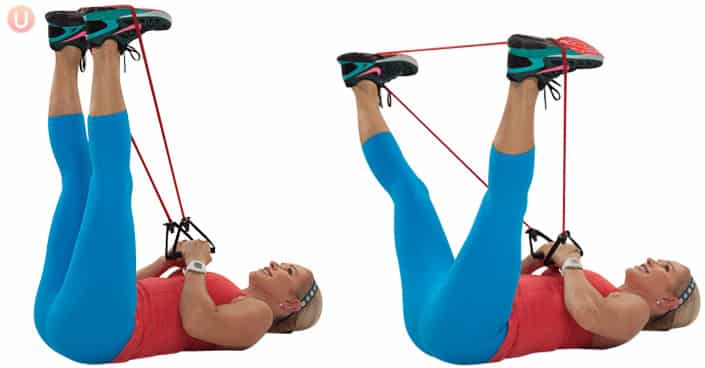


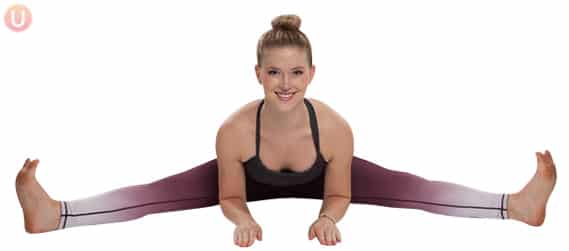
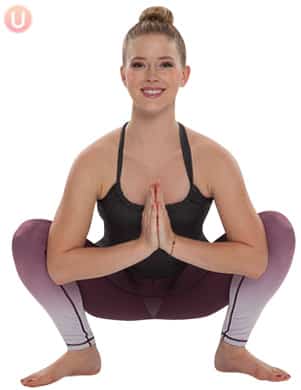
54 Comments
snake io on December 22, 2022 at 12:44 AM
I've had hip bursitis for nearly 15 years, and the left one is very painful at night no matter what exercises I perform. I occasionally get relief from lavender oil. Had cortisone injections, but they were unsuccessful. I've started seeing an osteopath in the hopes that he can assist me. Please offer any further recommendations. I work a sedentary job where I spend most of my time sitting down.
Chris Freytag, CPT on December 27, 2022 at 1:02 PM
Wow - sounds like you have tried a lot of different remedies for your hip bursitis. Does your hip feel better the more movement you get in the body or does that hurt it? Curious if more "low impact" movement helps or makes things worse.
Crystal on December 3, 2022 at 11:49 PM
I have been suffering from hip pain for as long as I can remember. I did have a complete spinal fusion with Herrington rods inserted due to Scheuermann’s Disease at 15 yrs old. I did not experience any pain until I had my third child. After that, the pain symptoms started in different areas and pain gradually became worse. I do not know if it has been a contributing factor to the bursitis and all of the arthritis that has set up in different joints in my body. I found one simple solution that has AT THE LEAST given me opportunity to actually sleep and it’sa small curved knee pillow, or ( foam ). I saw it on TV and they sell them at different places but I found mine at Dollar General for about $10-$15. It’s been the thing I’ve ever bought from this store! I urge you to try it. It is small and it is grooved to fit right between your knees without it feeling s awkward when you sleep. I hope you can find some relief however you do !
Denise on November 30, 2022 at 2:46 AM
Is there any equipment I can use for hip bursitis as I hate doing ordinary exercise. I know this sounds stupid but I would sooner use something.
Chris Freytag, CPT on February 14, 2023 at 2:27 PM
Unfortunately I am not sure of any equipment that is going to help you strength your hips with hip bursitis. There is definitely equipment that will protect your hip, a heating pad, and also foam rollers that are pieces that you can use to help with exercises. But you are going to have to do the stretching and training on your own for this one. I will do some more research, but most exercises you can do for hip bursitis include your own body and exercises to do on your own.
Brian on August 16, 2022 at 9:30 PM
Get rid of dairy and sugar, solved my hip problems.
Bridgett A Freeman on August 11, 2022 at 10:17 AM
Any suggestions to help with my Bursitis. I am 58 years old and active but it is flaring up again and no matter what I do I can not get the pain to go away. I was just into my Ortho Doctor for Injections into my Knee Left which is same hip that I have Bursitis in, she has order physical therapy for my with deep tissue massage as well to see if that will help. I do take anti inflammatory meds already for my knee as I do have severe arthritis, I need Knee Replacement but not ready to do it yet. Thus the injections 1 to 2 times a year. Other than that I stay active and keep moving and can do my activities with no issues
CBD gummies on July 9, 2022 at 5:45 AM
Thank you very much for your good recommendations on doing exercises for good health of the hip joint, not everyone will be able to perform such an exercise with very severe pain, but for those who can perform such an exercise, it's just super cool. Thank you very much!!!
MARY CLAYBON on June 5, 2022 at 7:44 AM
This was so helpful. I am a walker and make sure I get 10,000 steps a day. I have had bursitis in the past and it’s back with a vengeance. The pain is in the outside of the left hip and radiates down my leg to the outside if the knee. I’m also a writer and spend lots of time sitting. My downfall is an imbalance of movement- not enough stretching and strengthening. What is the most well rounded routine. Walking is meditation and medication to me. Hate to withdraw. Love yoga and tai chi but not doing that now.
Chris Freytag, CPT on June 7, 2022 at 11:06 AM
Way to get 10,000 steps in your day. My question would be are you strength training and are you stretching your body as well? I would suggest trying a strength routine to make sure your bones are strong as well. Try this routine here for stretches for hip bursitis!
Jessica on January 31, 2022 at 6:34 PM
Hi- I’m 37 and dealing with hip bursitis in my right hip. I find restorative Pilates reformer classes to be quite helpful. A lot of the stretches you recommend are in these classes and then some. It’s a slow progression of strength and to only what my body can manage. I only have a flare-up if I do the activities I’m not suppose to, (running, long bike rides, etc.) The last time I flared it up, I was lifting our 86 lb dog up in an emergency and jerked my hip. Well, back to basic care. But the Pilates helps… and I find turmeric (with black pepper) does as well. Thanks for the article. My chiropractor diagnosed my hip bursitis.
Kathy on January 6, 2022 at 6:48 AM
I had a lot of trouble with this too but I found the thing that helped me the most was wading in water up to my knees a couple of times a week for about 15 mins. Did this for about 3 months and pretty good now.
Jan L Joyce on December 29, 2021 at 8:56 AM
I was suffering from a bit of bursitis in my hips, i.e. very stiff and painful in the morning, but after I increased my intake of potassium- rich foods such as bananas, avocados and white beans, it has subsided completely. If I skip those foods for a few days, it comes back, hence I feel certain that it is the cure.